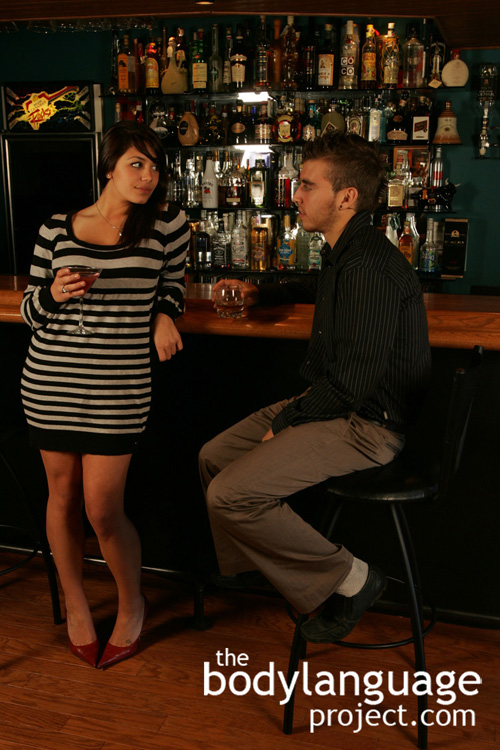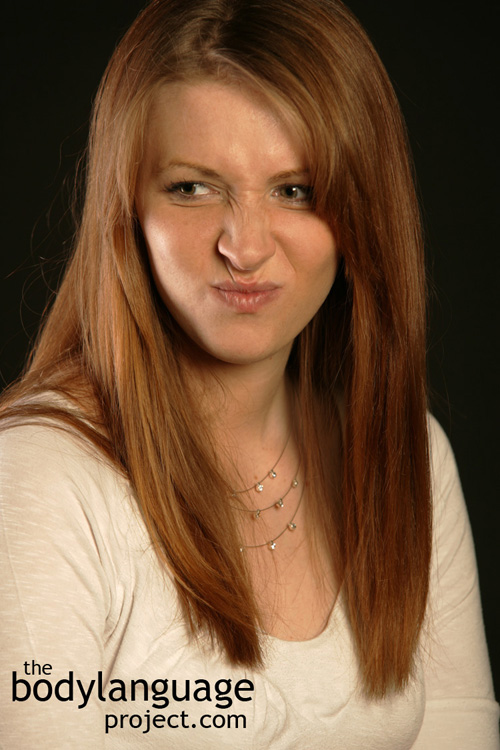Body Language of Standing Square
Synonym(s): Face-To-Face Standing Position, Head-On Standing Position, Competitive Head-To-Head Standing Position.
Description: When people who are speaking to each other stand or sit facing each other directly head-on.
In One Sentence: Standing square or face-to-face signals direct competition or high intimacy.
How To Use it: Stand square when you are prepared to be isolated from other people while being totally engrossed in the person who compliments your position.
This works well in dating to create intimacy, but also in battle when one squares off against an opponent. Men should avoid standing square with women unless they believe that romance is probable. In most cases, it is best to permit the women to show signs that a squared off stance is permitted. A man may chance a squared posture to see how a woman reacts. This will give him an idea about his current relationship status.
In confrontation, standing square is the highest order of aggression. It pits one person directly against another. Therefore, save this stance for when you feel that you can win the argument and you will not have to make a quick escape.
Context: a) General b) Business c) Dating.
Verbal Translation: a) “I’m sitting facing you head-to-head because we are in direct competition.” b) “We’re at odds with one another at opposing ends of the spectrum which is why we are facing off against one another.” c) “We are in love and stare blissfully into each others eyes.”
Variant: Standing At Forty-Five Degrees or Casual Corner Sitting Position, Angular Distance.
Cue In Action: a) Dave approached Mark directly, got right in his face and told him in no uncertain terms, “Don’t go near my girlfriend again.” b) The law firms were squared off, one team on the left, and the other team on the right.” c) The lovers looked each other deeply in the eyes before kissing.
Meaning and/or Motivation: It is either a confrontational orientation similar to those nearing, or in physical conflict or an intimate sitting and standing posture. Most people would state that standing square, face-to-face was the most honest and trustworthy position people orient themselves in while speaking with someone, but they would only be half right. In fact, most Americans stand at forty-five degrees or at oblique angles to one another.
Facing someone dead on, is how boxers square off to one another in the pre-show weigh-in or when two men near physical contact at a bar. The head on orientation is reserved for confrontation with just one exception; that is when two people are really comfortable with each other and are intimate.
Legal television dramas popularize this head-to-head seating position. Here each party faces directly across from the other person usually with their allies to their left and right solidifying their flanks. Another word for this position is the “closed” seating arrangement because it isolates people with the use of the desk. In the “open” arrangement a desk is pushed up against a wall and presents no barrier to visitors since they can access every part of a person when meeting with them. Closed positions convey formality, distance and authority, defensiveness and even divisiveness whereas open orientations convey interest and comfort.
Obviously this position should be avoided when cooperation and affiliation formation is desired as it has the reverse effect. The head-to-head position, when it is not expected, creates hostility and shows indifference.
When orienting at oblique angles it sends the message that we aren’t trying to corner each other. However, when we do sit or stand face-to-face it’s a demonstration of extreme comfort and trust. Other cultures don’t feel this way. Arabic cultures, for example, will speak with one another with their faces nearly touching and this often happens during normal conversation. Women in American cultures tolerate such closeness only from another woman. Men who do this to women will be perceived as sexually interested and be seen to be making a sexual come-on. If not welcomed, closeness will be a threat and turn-off, and in an office situation, should definitely be avoided.
Cue Cluster: Many times, the cue defines the context. For example, sitting head-on when sitting side-by-side is perfectly possible, tells the other group that we wish not to be cooperative. We might look to other cues and verbal dialogue to measure level of desire to cooperate or be competitive.
Body Language Category: Amplifier, Aggressive body language, Body pointing, Comfort body language, Courtship display, Hostile body language, Liking, Seated body pointing, Threat displays, Tie signals.
Resources:
Argyle, M., & Dean, I. Eye contact, distance and affiliation. Sociometry, 1965, 28, 289-304.
Boucher, Michael L. Holzberg, Jules D. (editor). Effect of seating distance on interpersonal attraction in an interview situation. Journal of Consulting and Clinical Psychology. 1972 38(1): 15-19.
Broth, Mathias and Lorenza Mondada. Walking Away: The Embodied Achievement of Activity Closings in Mobile Interaction. Journal of Pragmatics. 2013. 47: 41-58.
http://bodylanguageproject.com/articles/nonverbally-negotiate-conversation-walking-away/
Bania, Amanda E. ; Stromberg, Erin E. Call, Joseph (editor). The Effect of Body Orientation on Judgments of Human Visual Attention in Western Lowland Gorillas.
Journal of Comparative Psychology. 2013. 127(1): 82-90.
Belhiah, Hassan. Tutoring as an embodied activity: How speech, gaze and body orientation are coordinated to conduct ESL tutorial business. Journal of Pragmatics. 2009. 41(4): 829-841.
Broth, Mathias and Lorenza Mondada. Walking Away: The Embodied Achievement of Activity Closings in Mobile Interaction. Journal of Pragmatics. 2013. 47: 41-58.
http://bodylanguageproject.com/articles/nonverbally-negotiate-conversation-walking-away/
Cook, M. Experiments on orientation and proxemics. Human Relations, 1970, 23, 61-67.
Clack, B., Dixon, J., & Tredoux, C. (2005). Eating together apart: Patterns of segregation in a multi-ethnic cafeteria. Journal of Community & Applied Social Psychology, 15, 1-16. doi:10.1002/casp.787
Castelli, Luigi ; Carraro, Luciana ; Pavan, Giulia ; Murelli, Elisa ; Carraro, Alessia. The Power of the Unsaid: The Influence of Nonverbal Cues on Implicit Attitudes. Journal of Applied Social Psychology. 2012 42(6): 1376-1393.
Coutts, Larrym. ; Ledden, Maribeth. Nonverbal Compensatory Reactions to Changes in Interpersonal Proximity. The Journal of Social Psychology. 1977 102(2): 283-290.
Chance RMA (1962) An interpretation of some agonistic postures: the role of “cut-off” acts and postures. Symp Zool Soc Lond 8: 71–89.
Danielle Jackson, Erika Engstrom and Tara Emmers-Sommer. 2007. Think Leader, Think Male and Female: Sex vs. Seating Arrangement as Leadership Cues. Sex Roles. 57 (9/10): 713-723.
Eddie Harmon-Jones and Carly K. Peterson. Supine Body Position Reduces. Neural Response to Anger. Association for Psychological Science. 2009; 20 (10): 1209-1210.
http://bodylanguageproject.com/articles/supine-body-posture-reduces-aggression/
Felipe, N. Connotations of seating arrangements. Cornell Journal of Social Relations, 1967, 2, 37-44.
Gifford, Robert ; O’Connor, Brian. Nonverbal intimacy: Clarifying the role of seating distance and orientation. Journal of Nonverbal Behavior. 1986 10(4): 207-214.
Gardin, Hershel ; Kaplan, Kalman J. ; Firestone, Ira J. ; Cowan, Gloria A. Lanzetta, John T. (editor). Proxemic effects on cooperation, attitude, and approach-avoidance in a Prisoner’s Dilemma game. Journal of Personality and Social Psychology. 1973. 27(1): 13-18.
Greenberg, J. 1976. The role of seating position in group interaction: a review, with applications for group trainers. Group & Organization Management 1 (3): 310-327.
Haase, Richard F. ; Dimattia, Dominic J. Berdie, Ralph F. (editor). Proxemic behavior: Counselor, administrator, and client preference for seating arrangement in dyadic interaction. Journal of Counseling Psychology. 1970 17(4): 319-325.
Howells, L. T. and S. W. Becker. 1962. Seating arrangement and leadership emergence.
The Journal of Abnormal and Social Psychology 64(2): 148-150.
Hietanen, Jari. Social attention orienting integrates visual information from head and body orientation. Psychological Research.2002 66(3): 174-179.
Harrigan J. and Rosenthal R. Physicians’ head and body positions as determinants of perceived rapport. J. appl. Sot. Psychol. 13, 496, 1983.
Jackson, Danielle; Erika Engstrom and Tara Emmers-Sommer. 2007. Think Leader, Think Male and Female: Sex vs. Seating Arrangement as Leadership Cues. Sex Roles. 57 (9/10): 713-723.
Kaminski, Juliane ; Call, Josep ; Tomasello, Michael. Body orientation and face orientation: two factors controlling apes’ begging behavior from humans
Animal Cognition. 2004. 7(4): 216-223.
Kenner, Andrew N. ; Katsimaglis, George. Gender differences in proxemics: taxi-seat choice. Psychological Reports. 1993 72(2): 625(2).
Lawson, Rebecca P. ; Clifford, Colin W. G. ; Calder, Andrew J. About Turn: The Visual Representation of Human Body Orientation Revealed by Adaptation. Psychological Science. 2009. 20(3): 363(9).
Leventhal, G. 1978, Sex and setting effects on seating arrangement. Journal of Psychology. 100: 21-26.
Lott, D. F. and R. Sommer. 1967. Seating arrangements and status. Journal of Personality and Social Psychology 7 (1): 90-95.
Michelini, RL, Passalacqua, R., & Cusimano, J. 1976. Effects of seating arrangement on group participation. Journal of Social Psychology. 99: 179-186.
Mackinnon, Sean P. ; Jordan, Christian H. ; Wilson, Anne E. Birds of a feather sit together: Physical similarity predicts seating choice. Personality & Social Psychology Bulletin. 2011 37(7): 879(14).
Michelini, RL, Passalacqua, R., & Cusimano, J. 1976. Effects of seating arrangement on group participation. Journal of Social Psychology. 99: 179-186.
Mehrabian, Albert Holzberg, Jules D. (editor). Inference of Attitudes From the Posture, Orientation and Distance of a Communicator. Journal of Consulting and Clinical Psychology. 1968. 32(3): 296-308.
Mehrabian, Albert Deese, James (editor). Significance of posture and position in the communication of attitude and status relationships. Psychological Bulletin. 1969. 71(5): 359-372.
Montgomery, Derek ; Moran, Christy ; Bach, Leslie. The influence of nonverbal cues associated with looking behavior on young children’s mentalistic attributions.
Journal of Nonverbal Behavior. 1996. 20(4): 229-249.
Moore, Monica. Courtship Signaling and Adolescents: Girls Just Wanna Have Fun. Journal of Sex Research. 1995. 32(4): 319-328.
http://bodylanguageproject.com/articles/girls-just-want-to-have-fun-the-origins-of-courtship-cues-in-girls-and-women/
Norum, G.A., Russo, N.J., and Sommer, R. 1967. Seating patterns and group tasks. Source: Psychology in the schools. 4(3): 276-280.
Riess, M. and P. Rosenfeld. 1980. Seating preferences as nonverbal communication: a self-presentational analysis. Journal of Applied Communications Research 8(1): 22.
Remland, Martins. ; Jones, Tricias. ; Brinkman, Heidi. Interpersonal Distance, Body Orientation, and Touch: Effects of Culture, Gender, and Age. The Journal of Social Psychology. 1995 135(3): 281-297.
Robinson, Jeffrey David. Getting Down to Business Talk, Gaze, and Body Orientation During Openings of Doctor-Patient Consultations. Human Communication Research. 1998. 25(1): 97-123.
Straube, Benjamin ; Green, Antonia ; Jansen, Andreas ; Chatterjee, Anjan ; Kircher, Tilo. Social cues, mentalizing and the neural processing of speech accompanied by gestures. Neuropsychologia. 2010. 48(2): 382-393.
Stephenson, G. M. and B. K. Kniveton. 1978. Interpersonal and interparty exchange: an experimental study of the effect of seating position on the outcome of negotiations between teams representing parties in dispute. Human Relations 31(6): 555-566.
Scherer, S. E., & Schiff, M. R. Perceived intimacy, physical distance, and eye contact. Perceptual and Motor Skills, 1973, 36, 835-841.
Scott, J. A. Comfort and seating distance in living rooms: The relationship of interactants and topic of conversation. Environment and Behavior, 1984, 16, 35-54.
Sommer, R. Studies in personal space. Sociometry, 1959, 22,247-260.
Sommer, R. The distance for comfortable conversation: A further study. Sociometry, 1962, 25, 111-116.
Sommer, R. Personal space: The behavioral basis of design. Englewood Cliffs, New Jersey: Prentice Hall. 1969.
Underwood, M. K.. Glares of Contempt, Eye Rolls of Disgust and Turning Away to Exclude: Non-Verbal Forms of Social Aggression among Girls. Feminism & Psychology. 2004 14(3): 371-375
Weiss, M., & Keys, C. The influence of proxemic variables on dyadic interaction between peers. Paper presented at the meeting of the American Psychological Association; Chicago, 1975, August.
Zweigenhaft, R. L. 1976. Personal space in the faculty office: Desk placement and the student-faculty interaction. Journal of Applied Psychology 61 (4): 529-532.










